Tensions are escalating at Canada’s largest airline as contract negotiations between Air Canada and its flight attendant union have reached a critical impasse, forcing both parties to seek federal intervention through conciliation. This development signals growing labor unrest at a time when the aviation industry continues to navigate post-pandemic recovery challenges.
The Canadian Union of Public Employees (CUPE), representing approximately 9,500 Air Canada flight attendants, confirmed yesterday that negotiations have stalled over fundamental issues including wages, scheduling flexibility, and work-life balance concerns. Union officials describe the airline’s current offers as “woefully inadequate” given the rising cost of living and increased operational demands placed on cabin crew members.
“Flight attendants bore the brunt of pandemic-related layoffs and have returned to a workplace with heightened responsibilities and passenger tensions,” said Wesley Lesosky, president of CUPE’s Air Canada component. “Yet the compensation offerings fail to acknowledge these sacrifices or keep pace with inflation rates that have eroded purchasing power for many of our members.”
Air Canada management maintains they have presented a “competitive and fair” compensation package that balances employee needs with the airline’s financial recovery strategy. Company spokesperson Peter Fitzpatrick noted in a statement that the airline faces “significant cost pressures amid fierce industry competition” while emphasizing the carrier’s commitment to reaching an agreement that supports both operational stability and employee wellbeing.
Industry analysts watching the developments note that labor relations across the aviation sector remain strained. According to data from CO24 Business, airlines have seen operational costs increase by approximately 18% since 2019, while facing pressure to keep fares competitive to stimulate travel demand.
The move to conciliation, which involves appointing a federal mediator to facilitate negotiations, comes after several months of direct talks failed to produce meaningful progress. While the process doesn’t guarantee resolution, it represents a structured attempt to bridge significant gaps between the parties before more disruptive labor actions might be considered.
For Canadian travelers, the potential impacts remain uncertain. While no immediate service disruptions are anticipated, the Canada News desk has learned that union members have authorized leadership to escalate actions if necessary. Aviation industry expert Melanie Thompson from the Canadian Transportation Institute suggests consumers should monitor developments closely.
“While conciliation often leads to agreements, the particularly wide gap in expectations here could potentially lead to further labor action if compromise isn’t reached,” Thompson explained. “The summer travel season represents a particularly vulnerable period where disruptions would have maximized impact.”
The conciliation process is expected to begin within 20 days, with both parties required to work with the appointed mediator for a minimum period before further steps can be taken. The timing places potential pressure points squarely during peak summer travel months – a period when Air Canada typically sees its highest passenger volumes and revenues.
As Canadians increasingly return to air travel, with domestic passenger numbers approaching 90% of pre-pandemic levels according to Transport Canada data, the stability of airline operations takes on renewed importance for economic recovery and connectivity.
The fundamental question emerging from this labor dispute extends beyond just one airline: in an era of resurging travel demand but persistent economic pressures, who will ultimately bear the cost of aviation’s new operational reality – companies, workers, or passengers?










